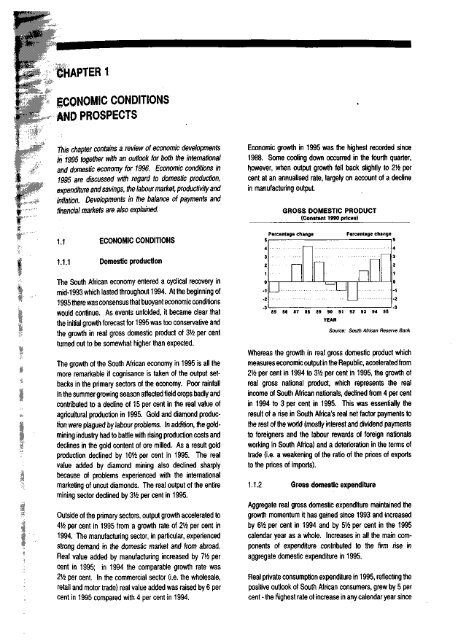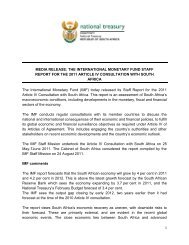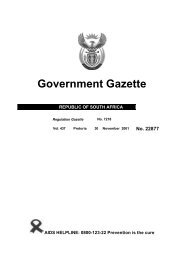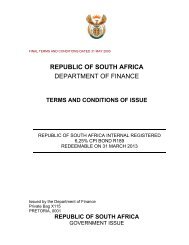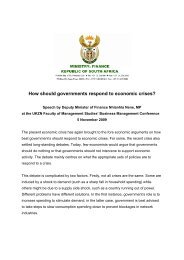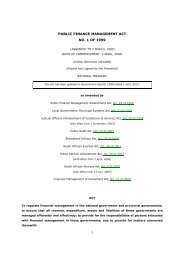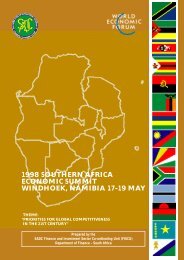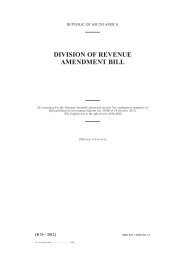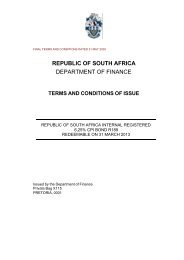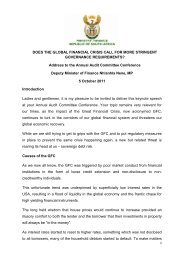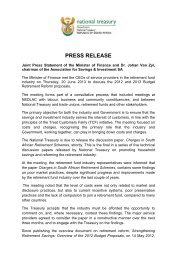1996 - National Treasury
1996 - National Treasury
1996 - National Treasury
You also want an ePaper? Increase the reach of your titles
YUMPU automatically turns print PDFs into web optimized ePapers that Google loves.
CHAPTER 1<br />
ECONOMIC CONDITIONS<br />
AND PROSPECTS<br />
This chapter contains a review of economic developments<br />
in 1995 together with an outlook for both the international<br />
and domestic economy for <strong>1996</strong>. Economic conditions in<br />
1995 are discussed with regard to domestic production,<br />
expenditure and savings, the labour market, productivity and<br />
inflation. Developments in the balance of payments and<br />
financial markets are also explained.<br />
1.1 ECONOMIC CONDITIONS<br />
1.1.1 Domestic production<br />
The South African economy entered a cyclical recovery in<br />
mid-1993 which lasted throughout 1994. At the beginning of<br />
1995 there was consensus that buoyant economic conditions<br />
would continue. As events unfolded, it became clear that<br />
the initial growth forecast for 1995 was too conservative and<br />
the growth in real gross domestic product of 316 per cent<br />
turned out to be somewhat higher than expected.<br />
The growth of the South African economy in 1995 is all the<br />
more remarkable if cognisance is taken of the output setbacks<br />
in the primary sectors of the economy. Poor rainfall<br />
in the summer growing season affected field crops badly and<br />
contributed to a decline of 15 per cent in the real value of<br />
agricultural production in 1995. Gold and diamond production<br />
were plagued by labour problems. In addition, the goldmining<br />
industry had to battle with rising production costs and<br />
declines in the gold content of ore milled. As a result gold<br />
production declined by 1016 per cent in 1995. The real<br />
value added by diamond mining also declined sharply<br />
because of problems experienced with the international<br />
marketing of uncut diamonds. The real output of the entire<br />
mining sector declined by 316 per cent in 1995.<br />
Outside of the primary sectors, output growth accelerated to<br />
41£ per cent in 1995 from a growth rate of 216 per cent in<br />
1994. The manufacturing sector, in particular, experienced<br />
strong demand in the domestic market and from abroad.<br />
Real value added by manufacturing increased by Vh per<br />
cent in 1995; in 1994 the comparable growth rate was<br />
2 1 /2 per cent. In the commercial sector (i.e. the wholesale,<br />
retail and motor trade) real value added was raised by 6 per<br />
cent in 1995 compared with 4 per cent in 1994.<br />
Economic growth in 1995 was the highest recorded since<br />
1988. Some cooling down occurred in the fourth quarter,<br />
however, when output growth fell back slightly to 2V4 per<br />
cent at an annualised rate, largely on account of a decline<br />
in manufacturing output.<br />
GROSS DOMESTIC PRODUCT<br />
(Constant 1990 prices)<br />
Percentage change<br />
Percentage change<br />
5i 15<br />
4 | 1 4<br />
3 ;•• — I |3<br />
2 I 1 I | 2<br />
1 I \ 1<br />
-2 I I -2<br />
.31 1.3<br />
85 86 87 88 89 90 91 92 93 94 95<br />
YEAR<br />
Source: South African Reserve Bank<br />
Whereas the growth in real gross domestic product which<br />
measures economic output in the Republic, accelerated from<br />
2 1 /2 per cent in 1994 to 3 1 /2 per cent in 1995, the growth of<br />
real gross national product, which represents the real<br />
income of South African nationals, declined from 4 per cent<br />
in 1994 to 3 per cent in 1995. This was essentially the<br />
result of a rise in South Africa's real net factor payments to<br />
the rest of the world (mostly interest and dividend payments<br />
to foreigners and the labour rewards of foreign nationals<br />
working in South Africa) and a deterioration in the terms of<br />
trade (i.e. a weakening of the ratio of the prices of exports<br />
to the prices of imports).<br />
1.1.2 Gross domestic expenditure<br />
Aggregate real gross domestic expenditure maintained the<br />
growth momentum it has gained since 1993 and increased<br />
by 616 per cent in 1994 and by 516 per cent in the 1995<br />
calendar year as a whole. Increases in all the main components<br />
of expenditure contributed to the firm rise in<br />
aggregate domestic expenditure in 1995.<br />
Real private consumption expenditure in 1995, reflecting the<br />
positive outlook of South African consumers, grew by 5 per<br />
cent - the highest rate of increase in any calendar year since


